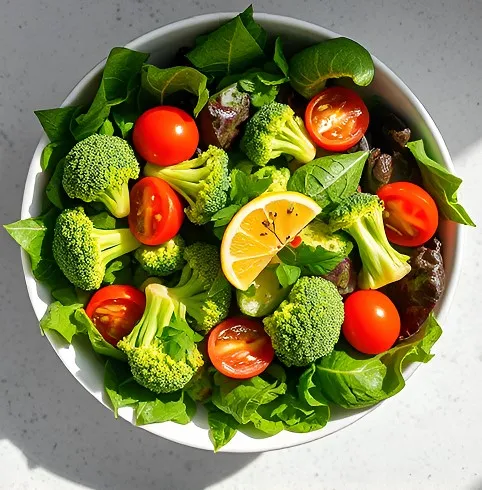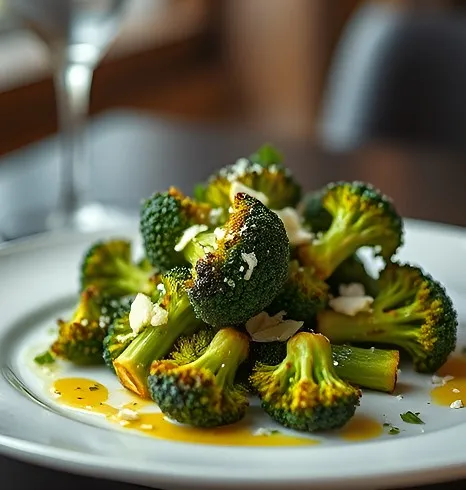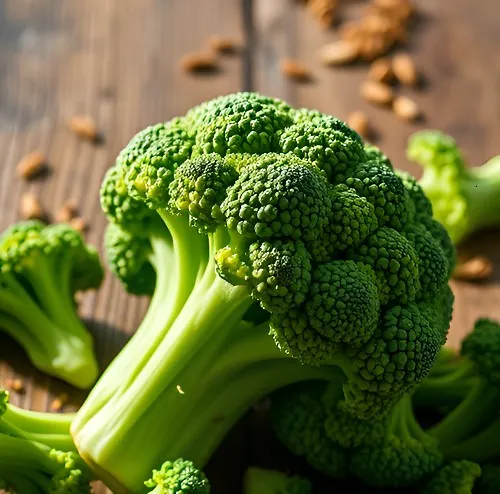Few vegetables deserve the spotlight quite like broccoli florets. Often pictured as little green trees with an unmistakable crunch, these clusters have evolved from a humble side dish into a superfood celebrated across kitchens and dining tables worldwide. In this comprehensive guide, we explore every aspect of broccoli florets—from their unique identity and nutritional prowess to practical tips on preparing them and even insights into their rich history. Whether you’re a seasoned chef looking to refresh your recipes or a curious foodie eager to learn more, read on to discover why broccoli florets might just become your new culinary obsession.
What Really Are Broccoli Florets and How Do They Differ from Broccoli?
At its core, broccoli is a member of the cabbage family, known for its edible flower clusters and sturdy stem. But what exactly distinguishes broccoli florets from the rest of the vegetable? The answer lies in the anatomy of the plant. While “broccoli” refers to the entire head—which includes the thick, fibrous stalk and the tightly packed buds—broccoli florets specifically denote those smaller, tree-like clusters that branch out from the central stem. These florets are essentially the immature flower buds, destined to bloom into a vibrant yellow flower if given the chance.
A closer look reveals that broccoli florets boast a lighter texture and more delicate flavor compared to the sturdier, somewhat bitter taste of the stalk. Although the stem carries many of the same nutrients as the florets, most culinary traditions focus on the florets because of their versatile texture and their ability to absorb flavors, whether raw in salads or transformed through cooking.
The visual appeal of these little green gems is undeniable. Their intricate structure not only makes them a favorite among health enthusiasts but also a beautiful garnish that adds a pop of color to any dish.
Mastering the Art of Cutting Broccoli Into Florets
For many home cooks, the process of transforming a whole head of broccoli into perfectly shaped florets may seem daunting. However, with a few simple techniques and some patience, you can quickly learn how to cut broccoli into florets without losing any of its nutritional goodness.
Begin by rinsing your broccoli under cool water to remove any dirt or residual pesticides. Once clean, gently pat the vegetable dry with a kitchen towel. Place the broccoli head on a stable cutting board, and with a sharp knife, slice through the thick stalk at the base of the flower head. This first cut gives you clear access to the clusters.
Next, inspect the structure where the florets meet the stem. Using your fingers, gently separate the florets by making short, upward cuts. Aim for pieces that are uniform in size; this helps ensure even cooking, whether you’re planning to steam, roast, or stir-fry your broccoli florets. Remember, it’s perfectly normal if some smaller pieces break off naturally during the process—they add texture and variation to your dish.
For those juggling a busy schedule, investing in a quality knife or even pre-cut broccoli available in many grocery stores can save time without sacrificing flavor or nutrition. Mastering this skill not only improves your presentation but also ensures that every part of your broccoli florets cooks to perfection, letting their natural flavors shine through.

The Nutritional Power of Broccoli Florets: A True Superfood
When it comes to packed nutrients, broccoli florets are in a league of their own. Low in calories yet rich in vitamins, minerals, and antioxidants, they offer a nutritional punch that few vegetables can match. For anyone seeking an easy way to boost health, these little florets provide an impressive array of benefits.
Each cup of raw broccoli florets delivers a significant dose of vitamin C—a powerful antioxidant that bolsters the immune system and combats oxidative stress in the body. Furthermore, they are an excellent source of vitamin K, which plays a critical role in bone health and proper blood clotting. The high fiber content in broccoli florets supports digestive health and contributes to a feeling of fullness, making these clusters a great addition to any weight management strategy.
Equally important is the presence of other vital nutrients such as folate, potassium, and iron. The antioxidants in broccoli florets work tirelessly to counteract free radicals, potentially reducing the risk of chronic conditions like heart disease and even certain types of cancer. Research consistently points to the benefits of including cruciferous vegetables in your meals, and broccoli florets are no exception—they make everyday dishes not just more colorful, but significantly healthier.
What sets broccoli florets apart is not only their taste and texture but also their ability to be incorporated into a variety of dishes without compromising nutritional integrity. Whether served raw, steamed, or roasted, these nutrient-dense clusters maintain their health benefits with proper preparation. For anyone aiming to cultivate a balanced diet, adding broccoli florets is a simple yet effective choice.

Creative Ways to Prepare and Enjoy Broccoli Florets
One of the best aspects of broccoli florets is their remarkable versatility in the kitchen. You may have encountered them as a side dish or a salad topping, but there’s a world of culinary potential waiting to be unlocked if you know how to make broccoli florets work for you.
For those who enjoy the crunch and purity of raw vegetables, a vibrant broccoli floret salad is an excellent choice. Combine fresh florets with mixed greens, cherry tomatoes, a splash of olive oil, and a sprinkle of lemon juice for a refreshing, nutrient-packed bowl that’s both satisfying and visually appealing.
If you prefer a warm dish, steaming is often the method of choice. Steaming broccoli florets helps retain their rich nutrient profile while softening them enough to absorb seasonings. A simple drizzle of olive oil, a pinch of sea salt, and a squeeze of lemon can transform these florets into a delectable, healthy side dish. Alternatively, roasting broccoli florets in the oven with garlic and a dusting of Parmesan cheese can yield a delightful mix of crispy edges and tender centers that elevate even the simplest meal.
For those with adventurous palates, swapping cooking techniques can lead to entirely new flavor experiences. Enhancing broccoli florets with a stir-fry is a great way to infuse them with the aromas of ginger, soy, and sesame. Another unexpected but delightful method is to incorporate them into smoothies—yes, you read that right! Although it might seem unusual at first, the subtle flavor of steamed broccoli florets blends well with fresh fruits and leafy greens, creating a well-rounded, nutrient-packed drink.
Every method of preparing broccoli florets has its own advantages. Light cooking methods help preserve the vitamins and enzymes, ensuring that you get maximum nutritional benefits. As you experiment with various techniques—from raw salads to roasted delights—you’ll find that these tiny clusters lend themselves beautifully to both simple and sophisticated recipes.
Sustainable Eating and the Rise of Broccoli Florets in Modern Cuisine
In today’s fast-paced world, factors like sustainability and ethical eating have become more integral to our food choices. Broccoli florets neatly fit into this narrative, as they are not only nourishing but also relatively sustainable to grow. They require a modest amount of water and can thrive in a variety of climates, making them an environmentally friendly option for conscious consumers.
Moreover, the modern culinary world is experiencing a surge in plant-based diets and innovative meal kits that focus on fresh, seasonal ingredients. Broccoli florets play a key role in many of these trends. Their versatility makes them an excellent ingredient for those who want to embrace healthier eating habits without sacrificing flavor or convenience. Grocery stores now offer pre-cut florets to cater to busy lifestyles, ensuring that no one has to miss out on the benefits of this superfood.
Restaurants and food bloggers alike are capitalizing on the growing trend of sustainability by reinventing traditional recipes with a modern twist—think broccoli floret pizzas, nutrient-rich grain bowls highlighted with steamed florets, or even broccoli-infused smoothies. These inventive adaptations underscore the dynamic potential of broccoli florets to transcend simple side dish status and become an integral part of a sustainable culinary movement.
Essential Tools and Pro Tips for Preparing Perfect Broccoli Florets
Even the most nutritious ingredient can lose its charm without the right preparation. Thankfully, there are several practical tools and techniques available that make it easier than ever to transform your broccoli into perfectly formed florets ready for any recipe. A quality chef’s knife, for instance, is indispensable for making clean, precise cuts. A sturdy cutting board not only ensures safety during the slicing process but also preserves the texture of the florets.
For those who lean toward steaming as their preferred cooking method, investing in a good steamer basket is a wise choice. This allows you to cook your broccoli florets evenly while locking in moisture and nutrients. In today’s era of meal prepping, many enthusiasts rely on food processors to quickly chop and separate florets, ensuring that you can prepare large batches of healthy vegetables in minutes.
Careful timing and mindful seasoning can elevate your broccoli florets from simple to sensational. A light dusting of sea salt, a drizzle of extra virgin olive oil, and a squeeze of fresh lemon juice can accentuate the natural flavor of the vegetable without overwhelming its delicate taste. As you experiment with your favorite spices—perhaps a pinch of garlic powder or a dash of crushed red pepper—you’ll discover that the right combination can transform your broccoli florets into a dish that’s both visually appealing and deliciously nutritious.
Incorporating these practical tips into your cooking routine not only improves the culinary experience but also ensures that every bite you take is packed with the natural goodness that broccoli florets have to offer.

Putting It All Together: Broccoli Florets in Everyday Cooking
Broccoli florets are more than just a nutritious vegetable; they are a canvas for culinary creativity. Whether you’re assembling a quick salad for lunch, crafting a gourmet dinner plate, or preparing a nutrient-packed smoothie, these florets offer endless possibilities to enhance both flavor and presentation.
Imagine a vibrant stir-fry where tender broccoli florets meet colorful bell peppers, snap peas, and a savory sauce. Or consider a roasted broccoli medley, where the florets develop a slightly crispy, caramelized edge while maintaining their tender center, perfectly complementing roasted potatoes and grilled proteins. Each method of preparation allows the inherent qualities of broccoli florets to shine.
Incorporating these versatile clusters into your daily meals also has a ripple effect on overall well-being. Their high vitamin and fiber content, combined with the antioxidant benefits, means that every dish becomes a small step toward better health. When paired with lean proteins, whole grains, and other vibrant vegetables, broccoli florets can truly make your meals both balanced and visually captivating.
For those who love experimenting, the realm of broccoli florets also extends into international flavors. Think about blending steamed florets into an Indian-inspired curry, where the natural sweetness of the vegetable contrasts beautifully with spicy, complex sauces. Or add them to a Mediterranean couscous salad featuring olives, tomatoes, and feta cheese—all designed to turn a simple vegetable into a star ingredient.
Ultimately, the magic of broccoli florets lies in their ability to adapt to every culinary style while imparting their distinctive flavor and robust nutritional profile. They serve not only as a centerpiece in many recipes but also as a testament to how nature’s bounty can be both delicious and incredibly healthful.
Frequently Asked Questions About Broccoli Florets
In an age where health and culinary mastery are in the spotlight, it’s only natural to have questions about this popular vegetable. Here are some of the most common questions and detailed answers to help you make the most out of broccoli florets.
What is the difference between broccoli and broccoli florets?
Broccoli refers to the whole head of the vegetable, complete with its thick stalk, dense leaves, and the crown of florets. Broccoli florets, on the other hand, are the flower buds that break away from the stalk. They have a more delicate texture and are preferred in many recipes for their tenderness and ability to absorb flavors.
How do you cut broccoli into florets?
Begin by washing the head of broccoli thoroughly. Use a sharp knife to cut through the main stalk beneath the crown. With your fingers or the knife, separate the smaller clusters from the central stem, taking care to keep the pieces relatively uniform. Even if some naturally break into smaller pieces, they add variety and texture to your dish. Regular practice will ensure that you achieve consistently even cuts every time.
Are broccoli florets healthy?
Absolutely. Broccoli florets are a nutritional powerhouse. They provide high levels of vitamin C, vitamin K, fiber, and a range of minerals and antioxidants. Studies suggest that diets rich in cruciferous vegetables like broccoli can lower the risk of chronic diseases such as heart disease and certain cancers. Furthermore, their low-calorie profile makes them an ideal choice for anyone looking to maintain or lose weight while still enjoying a nutrient-dense food.
How do you make broccoli florets for everyday meals?
There are countless ways to prepare broccoli florets. For a quick and nutritious side dish, try lightly steaming them until they achieve a bright green color and tender-crisp texture. Enhance with a drizzle of olive oil, a sprinkle of salt, and a dash of lemon juice. Alternatively, roasting broccoli florets in the oven with garlic or stirring them into a hearty stir-fry provides unique, flavorful alternatives that are as easy as they are healthful.
These FAQs not only clarify common uncertainties but also serve to inspire creative ways to incorporate broccoli florets into a balanced, delicious diet.
Embracing Broccoli Florets: A Final Word
In a culinary landscape brimming with trends and fleeting superfoods, broccoli florets have stood the test of time. Their journey—from humble beginnings in Mediterranean gardens to becoming a staple in contemporary healthy eating—is a testament to their enduring appeal. With their unmatched nutritional profile, ease of preparation, and endless versatility in recipes, these little green clusters have evolved into a beloved component of nutritious cookery.
For the busy home cook, mastering the art of cutting and preparing broccoli florets can be a game-changer. Not only do they elevate your dishes visually, but they also provide a burst of vitamins and antioxidants that help maintain overall well-being. Whether you decide to incorporate them as raw, lightly steamed, or roasted in your meals, broccoli florets offer a dynamic way to bring freshness, flavor, and health benefits to your table.
By understanding the differences between the whole vegetable and its florets, learning proper cutting techniques, and exploring creative cooking methods, you equip yourself with the tools to make every meal extraordinary. As more people embrace sustainable and plant-based diets, the spotlight on broccoli florets will continue to shine brighter. They remind us that sometimes, the simplest ingredients—when prepared with care—can have the most profound impact.
So, the next time you’re strolling through your local market or browsing the produce section, consider picking up a head of broccoli. With a little preparation and a dash of culinary creativity, you’ll soon be celebrating the many advantages of incorporating broccoli florets into your everyday meals, turning everyday dishes into nutrient-packed works of art.
In Conclusion
This journey through the world of broccoli florets reveals much more than a simple vegetable; it unveils a story of evolution, culinary innovation, and steadfast nutritional value. We explored how to distinguish broccoli florets from the rest of the broccoli plant, learned efficient techniques for cutting them, and uncovered the robust health benefits hidden within each tender bite.

